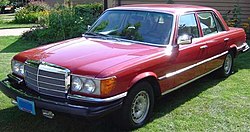Magic Alex
King Hussein of Jordan bought a fleet of cars that Mardas had customised, but then reportedly had the changes reversed when tests demonstrated them to be useless.
[4] Dunbar worked with Mardas on the "psychedelic light box" for the Rolling Stones' three-week tour of Europe in 1967,[5] although they were not impressed with the results.
[9] Mardas allegedly told Lennon about ideas for futuristic electronic devices he was "working on", which he later disavowed either promising or discussing: a telephone that responded to its owner's voice and could identify who was calling,[10] a force field that would surround the Beatles' homes, an X-ray camera, paint that would make anything invisible, car paint that would change colour by flicking a switch, and wallpaper speakers,[11] which would actually be a part of the wallpaper.
[9] Mardas later asked for the V-12 engines from Lennon's Rolls-Royce and George Harrison's Ferrari Berlinetta car, so he could build a flying saucer.
[12] The Beatles set up a company for Mardas called Fiftyshapes Ltd. in September 1967;[13] he later became one of the first employees of the newly formed Apple Corps, earning £40 a week (equivalent to £900 in 2023).
[18] Mardas was given his own laboratory called Apple Electronics, at 34 Boston Place, Westminster, London, and was helped to obtain a British work visa.
[12] His pay eventually rose to £6,000 per year (equivalent to £131,435 in 2023),[14][12] and an American patent attorney, Alfred Crotti, moved to England to assist Mardas.
[3] Their chartered yacht, the MV Arvi, was detained in Crete because of bad weather, so the party had to wait in Athens for three days.
[22] Taylor complained that on a trip to a small hill village, "We came round a corner of the peaceful road only to find hundreds of photographers clicking away at us", which Mardas had organised.
[30] Mardas appeared (uncredited) in the Beatles' TV movie Magical Mystery Tour,[13] which was first broadcast on BBC1 on Boxing Day in 1967.
On 11 July 1968, 26-year-old Mardas married 22-year-old Eufrosyne Doxiades (the daughter of a respected Greek architect) at St Sophia's Church, London.
[31] Mardas and Aspinall joined Lennon and Harrison in India, where they were studying meditation under the tutelage of Maharishi Mahesh Yogi; Starr had returned to England complaining that the Indian food did not agree with him, and McCartney had left on 24 March 1968.
After Cynthia had vomited in the bathroom she collapsed on a bed in the spare bedroom, but Mardas joined her and tried to kiss her until she (in her words) "pushed him away".
She said in 2005: "The mere fact that Magic Alex [Mardas] arrived in Italy in the middle of the night without any prior knowledge of where I was staying made me extremely suspicious.
[55] The only new piece of sound equipment present was a crude mixing console which Mardas had built, which looked (in the words of Martin's assistant, Dave Harries) like "bits of wood and an old oscilloscope".
[57] Mardas later stated that he had never been in the basement of Savile Row, as the studio equipment he was building was being tested in Apple Electronics, at Boston Place, Marylebone.
[59] In the film The Beatles: Get Back, Lennon wondered how he would play guitar with the strings of the bass against his hand, and noted that it was impossible to tune.
"[57] According to author Peter Doggett, in the Beatles' history, Mardas is the only individual who occupies a place close to Klein's in terms of vilification from commentators and biographers.
The second contract (worth over £1/2 million) allowed Mardas to set up new security companies: Alcom Devices Ltd, and Night Vision Systems Ltd (under the collective name of "Project Alcom") in St Albans Mews off Edgware Road, London, to provide a sophisticated communications system for Juan Carlos, so he could be in constant contact with his security services.
[64] King Hussein of Jordan had a fleet of cars that Mardas customised, but carried out a safety test on them with live ammunition in November 1977.
One eyewitness reported that the cars could be more life-threatening than ordinary vehicles, as bullets easily pierced the armour-plating, and the thick armoured glass broke into jagged splinters when struck.
[64] These failures convinced Mardas and Constantine to look at the growing European market for anti-terrorist protection, setting up a factory in London to produce "bullet-proof" cars in 1978.
[12] After an article on 18 September 1988 ("Joan's Secret Lover"), and another a week later, The People newspaper was taken to court by Mardas, who won £75,000 in damages.
[12] The Daily Mail published an apology and gave an undisclosed sum in damages on 16 January 2004, after an article on 11 June 2003, which accused Mardas of dealings that would later resurface in his claim against The New York Times in 2008.
[12] The Independent newspaper apologised on 21 August 2006, writing that on 14 June 2006, the paper had wrongly reported Mardas' involvement with Apple Electronics Ltd.
The paper accepted that Mardas "did not claim to have invented electric paint, a flying saucer or a recording studio with a 'sonic force field' or cause his employers to waste money on such ideas.
The Times's reporting on those events was attributed to Paul McCartney and based on widely published accounts from books and magazines".
Pepper's Lonely Hearts Club Band LP, and on the cover of Lennon and Ono's Unfinished Music No.1: Two Virgins), as well as a custom Vox Kensington guitar, a coloured felt pen drawing called "Strong", and a pen and ink drawing by Lennon entitled "Happy Fish".


